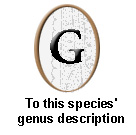

|
Photo Gallery-Forensic Nematology Genus Comparisons- Cephalobidae |
|
|
.5 mm | ||||
| 4.2 | 21. | 28. | 64. | 92.1 | |
| 2.6 | 6.3 | 6.8 | 7.5 | 3.4 | |
|
|
.59 mm | ||||
| 4.2 | 22. | 29. | M | 92 | |
| 2.3 | 4.7 | 5. | 6. | 4. | |
Wing areas similar to those described for complexus.The
cephalic probolae are bordered by long, triangular, acute membranes.
The labial probolae ar bifurcate three-fifths their length, their prongs
ending in slender, forward-pointing branches. Long, triangular, acute
membranes fringe the labial probolae. Strong cutinized points are
present at the bases of the labial probolae. The third and fifth
sets of pharyngeal plates are usually inconspicuous. The renette pore lies
almost half the distance from the cardiac bulb to the head, a very distinctive
feature. The lips of the small vulva are slightly elevated.
Eggs are two and one-half times as long as the vulva body-diameter and
one-third as wide as long. The phasmids lie far forward at a point
almost opposite the anus.
The tail of the male bears seven pairs of papillae. Spicula arcuate
and cephalated. Accessory piece linear and arcuate. Males rare,
only two being found among about 125 specimens.
Usually found in foothill or mountain soil, rarely from cultivated
fields.
(Description- Thorne, 1925)
DNA Sequences Obtained
| Specimen: | Collected: |
| Konza ICC-135 | Konza Prairie, First survey |
 |
 |